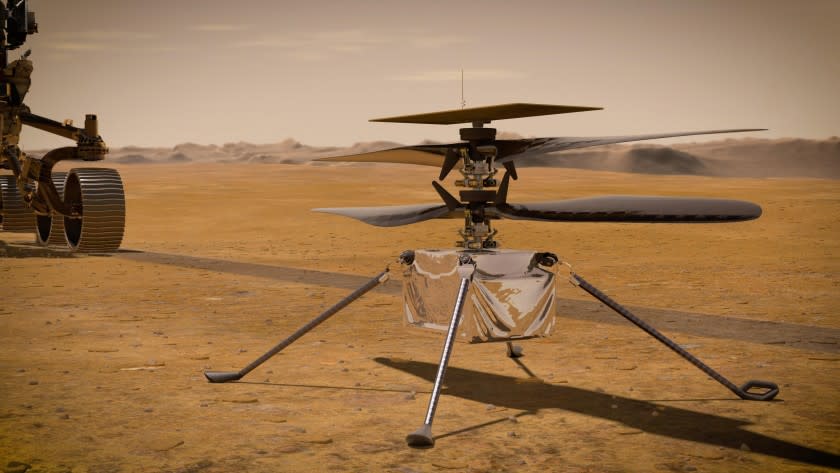Op-Ed: Going to Mars in a time of pandemic

At no other point in my life have I been happier to spend time in a different world. On my laptop screen is a breathtaking vista of Mars, recently captured from a camera on NASA’s Curiosity rover. It shows the rise of a cresting butte, a chain of undulating cliffs and a stunning patchwork of rocks, all carrying echoes of the planet’s history. Soon, another American rover — Perseverance — will land on the Martian surface, unfurl its instruments and set off to explore an exquisitely preserved river delta for signs of ancient life. That mission, and two more from other nations, will take us closer to Mars’ mysteries and farther from our own world, where unrelenting death and disease seem to have encircled us all.
I’m not the first scientist to find solace in thinking about Mars. When the United States was engulfed in widespread economic depression in 1894, Percival Lowell set up an astronomical outpost in the Arizona Territory, “far from the smoke of men.” From his solitary perch, he charted mysterious lines across the face of the planet, right up to polar caps. To him, they could only be irrigation canals, the handiwork of a brilliant, benevolent civilization.
In 1914, as menace gathered across Europe, William Pickering began composing poignant Martian weather reports. He described what he believed to be the coastlines of blue-tinted bays and belts of cumulus clouds sweeping the sky. As the atrocities of World War I amassed, he depicted Mars as a kind of a wilderness refuge, free from suffering, injustice and brutality. Just vegetation. Just weather.
For years, Mars was unknown and inaccessible, the ideal terra nova for this kind of escapism, merely a dot in the sky, something like an exoplanet today: far beyond our reach, without a known topography, mineral composition or history.
The planet we’ve come to know more recently is a less cooperative muse. It is relentlessly harsh, and, so far as we know, lifeless — certainly no cradle of civilization. But our understanding of Mars is also far more vivid than ever before. We recognize where ancient ponds once lapped against the hills. We know how to find arcing dunes and delicate layers of frost. We’ve even detected a vast and hidden subglacial lake that Lowell, Pickering and others, for all their imagination, could never have envisioned.
Our view of Mars as a blank canvas has given way to more interesting science. My own lab, for example, is grappling with what a truly alien life form might look like. The effort is the opposite of seeing lines and inferring canals, or of searching only for what we know. Instead, we are designing tools and techniques to recognize life as we don’t know it, leaving behind as many Earth-born suppositions as we can. It’s a beguiling challenge, like trying to imagine a color we’ve never seen, and it comes with the possibility of a find as staggering as any in the history of modern science.
With stakes like these, it’s no wonder that more resources and energy are being focused on our near neighbor than ever before. This month, a window of opportunity for exploration has opened as Earth and Mars swing close to one another, an event that only happens every couple of years.
From Hainan Island in China, an orbiter and lander with a mobile rover just launched for the plains of Utopia. The Chinese mission is called Tianwen-1, or the “Questions to Heaven,” after the name of a poem penned by an ancient poet. From the Tanegashima Space Center in Japan, the United Arab Emirates sent its first planetary probe, an orbiter named Hope. And from Cape Canaveral, NASA will soon send Perseverance, alongside a small whirring companion, a helicopter named Ingenuity. NASA’s mission will begin an ambitious international campaign to collect samples that will eventually return to Earth, little bits of Mars that might hold molecular fossils of life.
When I think about the convulsions here on Earth, it feels like Perseverance will not so much fly atop an Atlas V rocket as catapult out of our country’s soul. Sometimes, I struggle to justify the effort, the expense, but I do believe there are reasons to press on in our exploration. As the global pandemic rages on, I know we need all kinds of science more than ever before. What we discover on Mars could help us understand more about the nature of biology, about how forms of life come into being and survive. Few other discoveries would tell us as much about ourselves and our universe as discovering extraterrestrial life — especially if there were evidence of a second genesis.
The missions speak to me on an immediate level, too. To travel to another planet and put a rover on its surface now feels like a rebuke to the powerlessness we feel here at home. These probes, built by human hands, will hurtle millions of miles across space. They will journey all the way to another world, the most distant frontier we can touch — so far — in a meaningful way. Whereas Mars was a dreamscape to my predecessors, it is now a proving ground, a measure of our faith in the future, and a reminder of one of the most profound things our civilization can do.
Sarah Stewart Johnson is an associate professor at Georgetown University, a visiting scientist with NASA’s Goddard Space Flight Center, and the author of "The Sirens of Mars."
This story originally appeared in Los Angeles Times.

